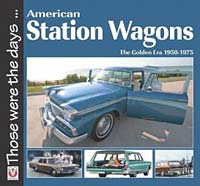|
Veloce Publishing's list of titles in their "Those Were The Days" series grows ever more. This softback publication, written by Norm Mort, guides the reader through the subject of post-war American station wagons, or estate cars, a field within the hobby of collecting classic cars that I find quite interesting, having owned one or two ancient estates in the past.
|
|
The book was written by an American, and the preserved cars featured within this book's 96 pages were all sourced on that side of the Atlantic. Following the introduction, the reader is given an overview of station wagons and how they came to be so popular throughout the 20th Century. Early vehicles were fairly utilitarian, while those of the 1930s and 1940s were becoming equally as well equipped as their four-door sedan cousins. No longer would buyers tolerate a reduction in their driving comfort just because they had a large family, or mountain of equipment, to cart around with them while cruising the highways of the USA.
|
|
The first chapter concentrates on the wagons of 1945 to 1949. Whereas pre-war vehicles usually employed a great deal of wood in their construction, in the immediate post-war era designers were turning towards all-steel creations, perhaps the first being the Jeep-based wagon of 1946. As the years rolled on, other manufacturers would introduce their own estate-car versions, often featuring wood-effect panels on their side as a nod to designs of the 1930s.
|
|
Not all American cars of the post-war era were chrome-laden machines of epic proportion. One of the rarest, and most collectable today, is the compact two-door Crosley Station Wagon, a tiny (relatively) vehicle propelled by a motor of a mere 44 cubic inches (721cc). Sold alongside saloon, convertible and pickup versions, the pint-sized Crosley was a strong seller.
|
|
The Carry-All is also introduced at this point. Usually a larger vehicle, based on commercial vehicle running gear, they sold alongside their station wagon cousins and offered the benefits of more rugged mechanicals, with the flexibility of a wagon.
|
|
The book is illustrated throughout with, in the main, period photographs, and illustrations copied from contemporary advertising material. Chapter two moves on to the cars of 1950-1959, again colourfully illustrated with period imagery and notes to accompany them. The 1950s would start out with reasonably sober-looking cars, developing year-on-year into the ultimate in be-finned monsters, dripping in chrome plating, bright cheerful interior trim, and all the latest gadgets to keep the American motorist amused. Cars of all the popular makes of the era are mentioned, including Chrysler, Chevrolet, Ford and Studebaker.
|
|
The dawn of the 1960s saw a return to more modestly-designed cars and estates. That's not to say though that there were no innovative designs coming on stream, just that they were a little less ostentatious than those that had followed before. The Studebaker Wagonaire for instance was a very interesting car, incorporating a drop tailgate and a sliding rear roof section, enabling tall items to be carried in the rear cargo area.
|
|
By the 1970s, the fad of glueing wood-effect trim to the outside of America's enormous station wagons was showing no sign of slowing, and the brochures of AMC and Ford for instance included a number of cars with these styling appendages. The future was looking rosy - right until the oil crisis kicked in, and suddenly the market for huge, thirsty land-yachts was looking somewhat more unsettled. Large engines were losing favour rapidly, with many muscle cars of the era also being axed. The American-built station wagon had to evolve if it was to survive.
|
|
Cars such as the Ford Pinto and the AMC Hornet Sportabout came on stream, continuing to offer practicality and middle-class respectability, while downsizing their appetite for fuel. Large-engined models were still in production, the Chrysler Town & Country Wagon for instance still commanded a sizeable footprint, but smaller and smaller cars and engines were definitely beginning to look attractive, at a time when gas shortages were becoming commonplace across the States. Factory shots of these classic wagons, again illustrate this gradual shift in buyers' priorities.
|
|
As 1975 is the cut-off, the remainder of this slim publication takes a brief look at the preservation of older station wagons by car collectors today, while one or two cars of recent production also receive a mention.
|
|
This is a well-priced book that forms a good overall introduction to the subject. Anyone with a passion for these practical, and sometimes quite rare, cars will find something of interest here, and - as a lightweight rather than in-depth take on the subject - it's worth a read.
|
|
RJ
|
|
Back to top
|
|
Return to the Book Reviews main page
|





